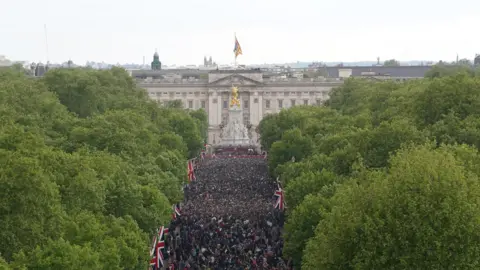The recent commemoration of the 80th anniversary of Victory in Europe (VE) Day drew significant attention as three generations of the Royal Family gathered on the balcony of Buckingham Palace. Aerial displays, particularly a flyover featuring the renowned Red Arrows and a vintage Lancaster bomber, marked the occasion that honors the conclusion of World War Two in Europe. This year stands as a poignant reminder, as it is the first VE Day marked without the late Queen Elizabeth II, who passed away in 2022.
The flypast formation featured 23 military aircraft, including modern Typhoons and the iconic Red Arrows trailing red, white, and blue smoke. The King, who is presiding over the four-day celebrations, was notably joined by senior royals, including the Prince and Princess of Wales, as well as their children, Prince George, Princess Charlotte, and Prince Louis. The royal family has expressed the desire for this remembrance to remain undisturbed, especially in light of recent public discussions involving Prince Harry and his reflections on family dynamics.
The historical significance of VE Day—declared on May 8, 1945—carries tremendous weight as it symbolized the end of the conflict with Nazi Germany. At 3:00 PM that day, then-Prime Minister Winston Churchill delivered his iconic announcement, igniting celebrations that erupted spontaneously across the United Kingdom and beyond. Many citizens recall the jubilation of those days; for instance, a significant crowd gathered along The Mall, a major thoroughfare leading to Buckingham Palace, to participate in the day’s events, marking the importance of remembering those who fought for freedom.
Part of the celebrations included a military procession that moved from Parliament Square to Buckingham Palace, featuring over 1,300 participants. As they approached the Queen Victoria Memorial, King Charles III stood and saluted, an homage to the bravery and sacrifices made by veterans. The Prince and Princess of Wales were seen interacting with veterans amongst the cheering crowds, showcasing a familial connection to the history being commemorated.
The spirit of shared memory extended beyond just the royal family and veterans, with community members actively participating in the festivities across the nation. Street parties were organized in many towns, providing an opportunity for people to come together in remembrance. Notably, Portsmouth waived road closure fees to facilitate the celebrations, encouraging public engagement. Other cities and landmarks, such as the Palace of Westminster and the Shard, illuminated their buildings at night in solidarity with the celebrations.
Attendees, including families and veterans, reflected on the importance of commemorating the past. For instance, attendees like Maria and Chris Naynor, whose familial ties to military service go back to WWII, emphasized their duty to remember those who sacrificed their lives for future generations. They arrived early, armed with cream tea and refreshments, showcasing a blend of tradition and celebration.
The Royal Family hosted various other events as well, aiming to connect with veterans and express gratitude for their service. In a notable gesture, King Charles III and Queen Camilla were scheduled to host a tea party for about 50 veterans later in the day, reaffirming their commitment to honor the service of all those involved in the war effort.
Overall, as Britain reflects upon this significant milestone, the day served as a powerful reminder of the enduring legacy of those who fought during World War II, while also emphasizing the importance of unity and remembrance in the face of generational change. The royal family’s involvement illustrates not only the continuing tradition of honoring history but also the relevance of that history in contemporary society. As the country moves forward, the hope remains that lessons learned from the past foster a spirit of unity and peace among all.



